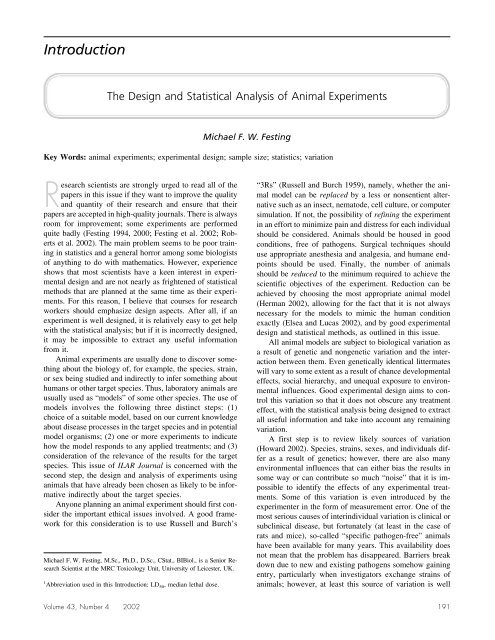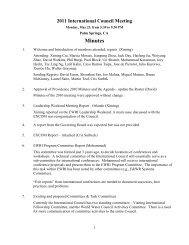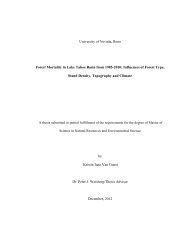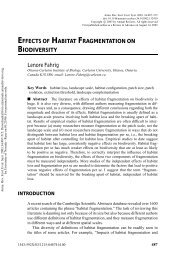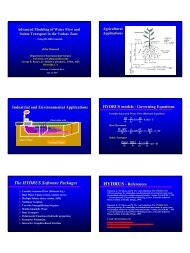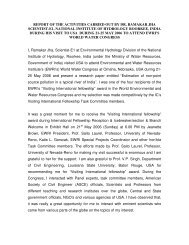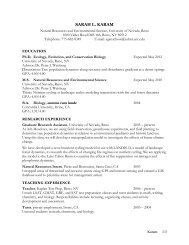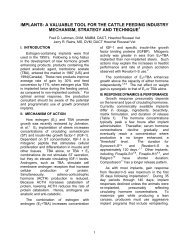Design and Statistical Analysis of Animal Experiments
Design and Statistical Analysis of Animal Experiments
Design and Statistical Analysis of Animal Experiments
You also want an ePaper? Increase the reach of your titles
YUMPU automatically turns print PDFs into web optimized ePapers that Google loves.
IntroductionThe <strong>Design</strong> <strong>and</strong> <strong>Statistical</strong> <strong>Analysis</strong> <strong>of</strong> <strong>Animal</strong> <strong>Experiments</strong>Michael F. W. FestingKey Words: animal experiments; experimental design; sample size; statistics; variationResearch scientists are strongly urged to read all <strong>of</strong> thepapers in this issue if they want to improve the quality<strong>and</strong> quantity <strong>of</strong> their research <strong>and</strong> ensure that theirpapers are accepted in high-quality journals. There is alwaysroom for improvement; some experiments are performedquite badly (Festing 1994, 2000; Festing et al. 2002; Robertset al. 2002). The main problem seems to be poor trainingin statistics <strong>and</strong> a general horror among some biologists<strong>of</strong> anything to do with mathematics. However, experienceshows that most scientists have a keen interest in experimentaldesign <strong>and</strong> are not nearly as frightened <strong>of</strong> statisticalmethods that are planned at the same time as their experiments.For this reason, I believe that courses for researchworkers should emphasize design aspects. After all, if anexperiment is well designed, it is relatively easy to get helpwith the statistical analysis; but if it is incorrectly designed,it may be impossible to extract any useful informationfrom it.<strong>Animal</strong> experiments are usually done to discover somethingabout the biology <strong>of</strong>, for example, the species, strain,or sex being studied <strong>and</strong> indirectly to infer something abouthumans or other target species. Thus, laboratory animals areusually used as “models” <strong>of</strong> some other species. The use <strong>of</strong>models involves the following three distinct steps: (1)choice <strong>of</strong> a suitable model, based on our current knowledgeabout disease processes in the target species <strong>and</strong> in potentialmodel organisms; (2) one or more experiments to indicatehow the model responds to any applied treatments; <strong>and</strong> (3)consideration <strong>of</strong> the relevance <strong>of</strong> the results for the targetspecies. This issue <strong>of</strong> ILAR Journal is concerned with thesecond step, the design <strong>and</strong> analysis <strong>of</strong> experiments usinganimals that have already been chosen as likely to be informativeindirectly about the target species.Anyone planning an animal experiment should first considerthe important ethical issues involved. A good frameworkfor this consideration is to use Russell <strong>and</strong> Burch’sMichael F. W. Festing, M.Sc., Ph.D., D.Sc., CStat., BIBiol., is a Senior ResearchScientist at the MRC Toxicology Unit, University <strong>of</strong> Leicester, UK.1 Abbreviation used in this Introduction: LD 50 , median lethal dose.“3Rs” (Russell <strong>and</strong> Burch 1959), namely, whether the animalmodel can be replaced by a less or nonsentient alternativesuch as an insect, nematode, cell culture, or computersimulation. If not, the possibility <strong>of</strong> refining the experimentin an effort to minimize pain <strong>and</strong> distress for each individualshould be considered. <strong>Animal</strong>s should be housed in goodconditions, free <strong>of</strong> pathogens. Surgical techniques shoulduse appropriate anesthesia <strong>and</strong> analgesia, <strong>and</strong> humane endpointsshould be used. Finally, the number <strong>of</strong> animalsshould be reduced to the minimum required to achieve thescientific objectives <strong>of</strong> the experiment. Reduction can beachieved by choosing the most appropriate animal model(Herman 2002), allowing for the fact that it is not alwaysnecessary for the models to mimic the human conditionexactly (Elsea <strong>and</strong> Lucas 2002), <strong>and</strong> by good experimentaldesign <strong>and</strong> statistical methods, as outlined in this issue.All animal models are subject to biological variation asa result <strong>of</strong> genetic <strong>and</strong> nongenetic variation <strong>and</strong> the interactionbetween them. Even genetically identical littermateswill vary to some extent as a result <strong>of</strong> chance developmentaleffects, social hierarchy, <strong>and</strong> unequal exposure to environmentalinfluences. Good experimental design aims to controlthis variation so that it does not obscure any treatmenteffect, with the statistical analysis being designed to extractall useful information <strong>and</strong> take into account any remainingvariation.A first step is to review likely sources <strong>of</strong> variation(Howard 2002). Species, strains, sexes, <strong>and</strong> individuals differas a result <strong>of</strong> genetics; however, there are also manyenvironmental influences that can either bias the results insome way or can contribute so much “noise” that it is impossibleto identify the effects <strong>of</strong> any experimental treatments.Some <strong>of</strong> this variation is even introduced by theexperimenter in the form <strong>of</strong> measurement error. One <strong>of</strong> themost serious causes <strong>of</strong> interindividual variation is clinical orsubclinical disease, but fortunately (at least in the case <strong>of</strong>rats <strong>and</strong> mice), so-called “specific pathogen-free” animalshave been available for many years. This availability doesnot mean that the problem has disappeared. Barriers breakdown due to new <strong>and</strong> existing pathogens somehow gainingentry, particularly when investigators exchange strains <strong>of</strong>animals; however, at least this source <strong>of</strong> variation is wellVolume 43, Number 4 2002 191
known <strong>and</strong> is under control to the extent possible. Less wellknown are some <strong>of</strong> the effects <strong>of</strong> source <strong>of</strong> animals, husb<strong>and</strong>ry,housing (including the effects <strong>of</strong> environmental enrichment),diet, <strong>and</strong> social interaction among groupedanimals. Failure to account for some <strong>of</strong> these variables at thedesign stage will certainly reduce the efficiency <strong>of</strong> any animalexperiment.Practical considerations also must be taken into account.It is important to survey the literature, clarify research questions,select model systems <strong>and</strong> available skills, <strong>and</strong> reviewequipment <strong>and</strong> staffing. When these practical aspects fallshort, it is advisable to identify collaborators <strong>and</strong> add astatistician to the research team if necessary. This is also thetime to choose treatments <strong>and</strong> outcomes <strong>and</strong> to formulate atentative design (Johnson <strong>and</strong> Besselsen 2002). Choosingthe right number <strong>of</strong> animals (or other “experimental units”)is particularly important. Choosing too few may result inmissing biologically important effects, whereas choosingtoo many will waste animals. <strong>Statistical</strong> power <strong>and</strong> samplesize calculations provide some guidance. Although the formulaeare complex, particularly for more advanced designs,it is usually possible to simplify the questions so that a goodapproximation <strong>of</strong> the optimum sample size can be obtainedusing one <strong>of</strong> the available statistical packages or an interactiveweb site (Dell et al. 2002).In any experiment, there are numerous variables, whichinclude the following: (1) “ancillary” variables such as species,strain, sex, husb<strong>and</strong>ry model preparation, <strong>and</strong> someaspects <strong>of</strong> the environment, which can be fixed by the experimenter;(2) variables such as diurnal variation, some <strong>of</strong>the measurement error, <strong>and</strong> observer differences, which canbe taken into account if they are known; <strong>and</strong> (3) additionalvariables such as differences between animals, which aredifficult or impossible to control. All <strong>of</strong> these variables formpart <strong>of</strong> the record <strong>of</strong> the experiment, but all too <strong>of</strong>ten, suchinformation is simply discarded. A range <strong>of</strong> methods areavailable for dealing with these variables, such as includingthem in the design by using r<strong>and</strong>omized block or Latinsquare designs, using them in the statistical analysis inscreening for outliers or using techniques such as covarianceanalysis to increase statistical power, or simply recordingthem so that other people know exactly what has beendone (Gaines Das 2002).Most experiments are performed using relatively simpledesigns such as completely r<strong>and</strong>omized, r<strong>and</strong>omized block,<strong>and</strong> simple factorial designs. However, there are many specializeddesigns <strong>and</strong> techniques that can be used effectivelyin some circumstances. Some experiments are performedrepeatedly with only minor changes in the applied treatments.Drug development <strong>of</strong>ten involves screening manyrelated compounds using the same animal model <strong>and</strong> design,<strong>and</strong> safety <strong>and</strong> potency testing <strong>of</strong> vaccines involvestesting different batches <strong>of</strong> product also using the samedesign. As noted above, large numbers <strong>of</strong> variables caninfluence the outcome. If such experiments are optimized byst<strong>and</strong>ardizing on the variables that result in the most clearcutdifferences, sample size can be reduced or the experimentscan be more powerful <strong>and</strong> able to detect more subtledifferences. Advanced factorial design <strong>of</strong>fers one method <strong>of</strong>assessing which, among a large number <strong>of</strong> controllable variables,are most important in determining the response <strong>and</strong>which can safely be ignored. Many combinations <strong>of</strong> factorssuch as strain, sex, age, weight, prior treatment, <strong>and</strong> measurementmethods can be tried without using excessivenumbers <strong>of</strong> animals (Shaw et al. 2002). When the optimumset has been identified, simpler designs using this combination<strong>of</strong> variables can be used.The use <strong>of</strong> animals in acute toxicity tests to determine amedian lethal dose (LD 50 1 ) has always been a controversialprocedure because it may involve excessive suffering. Severalimproved methods have now been developed that usefewer animals by relying on a sequential procedure. Suchdesigns are used when the result <strong>of</strong> a treatment on an individual(or small group) <strong>of</strong> animals can be obtained quicklyso that a decision on how to treat the next individual can bepursued. Typically, the first animal is given a dose thoughtto approximate the presumed LD 50 level. If it dies, the nextanimal is given a lower dose; however, if it survives, thenext animal is given a higher dose, <strong>and</strong> so on until theexperiment has homed in on a sufficiently precise estimate<strong>of</strong> the LD 50 , at which point the experiment is terminated.The so-called “up-<strong>and</strong>-down” method described herein usesfewer animals than the conventional test <strong>and</strong> has been optimizedusing computer simulations—a statistically <strong>and</strong>ethically better method than testing dose levels using realanimals (Rispin et al. 2002). The “fixed dose procedure”(Whitehead <strong>and</strong> Curnow 1992) <strong>and</strong> the “acute toxic class”methods (Schlede et al. 1992) have somewhat similar objectives<strong>of</strong> classifying the toxicity <strong>of</strong> chemicals, althoughthey do not result in estimates <strong>of</strong> the LD 50 .The articles in this issue cover so many aspects <strong>of</strong> whata scientist should <strong>and</strong> should not do to design a good animalexperiment that some scientists may end up in total confusion.The final article titled Guidelines for the <strong>Design</strong> <strong>and</strong><strong>Statistical</strong> <strong>Analysis</strong> <strong>of</strong> <strong>Experiments</strong> Using Laboratory <strong>Animal</strong>s(Festing <strong>and</strong> Altman 2002) aims to clarify the issuesby systematically going through the general principles involvedin designing, analyzing, <strong>and</strong> presenting the results <strong>of</strong>an experiment. Starting with a clear specification <strong>of</strong> theobjective <strong>of</strong> the experiment, the scientist should considerthe ethical implication <strong>of</strong> the study, the validity <strong>of</strong> themodel, sources <strong>of</strong> variation, <strong>and</strong> how some <strong>of</strong> these variablescan be controlled using formal, appropriately r<strong>and</strong>omized,experimental designs. It is important to choosecarefully the independent variable(s) or treatments, the dependentvariables (characters or outcomes), <strong>and</strong> the appropriatenumbers <strong>of</strong> animals. The proposed method <strong>of</strong>statistical analysis should be determined at the design stage.However, the data should be studied for possible anomalies<strong>and</strong> may require transformation to a different scale beforestatistical analysis using parametric or nonparametric methods.Finally, the results should be presented to clarifyexactly what was done <strong>and</strong> what was the outcome, “warts”<strong>and</strong> all.192 ILAR Journal
The design, analysis, <strong>and</strong> interpretation <strong>of</strong> biomedicalexperiments are best performed with the aid <strong>of</strong> a good statisticaltextbook, dedicated statistical s<strong>of</strong>tware, <strong>and</strong> advicefrom a statistician. Anyone reading <strong>and</strong> underst<strong>and</strong>ing thepapers presented here cannot fail to do better, more humaneanimal experiments in the future.ReferencesDell R, Holleran S, Ramakrishnan R. 2002. Sample size determination.ILAR J 43:207-213. 〈http://www.national-academies.org/ilar〉.Elsea SH, Lucas RE. 2002. The mousetrap: What we can learn when themouse model does not mimic the human disease. ILAR J 43:66-79.〈http://www.national-academies.org/ilar〉.Festing MFW. 1994. Reduction <strong>of</strong> animal use: Experimental design <strong>and</strong>quality <strong>of</strong> experiments. Lab Anim 28:212-221.Festing MFW. 2000. Common errors in the statistical analysis <strong>of</strong> experimentaldata. In: Balls M, van Zeller A-M, Halder ME, eds. Progress inthe Reduction, Refinement <strong>and</strong> Replacement <strong>of</strong> <strong>Animal</strong> Experimentation:Developments in <strong>Animal</strong> <strong>and</strong> Veterinary Science. Vol. 31a. Amsterdam:Elsevier. p 753-758.Festing MFW, Altman DG. 2002. Guidelines for the design <strong>and</strong> statisticalanalysis <strong>of</strong> experiments using laboratory animals. ILAR J 43:244-258.〈http://www.national-academies.org/ilar〉.Festing MFW, Overend P, Gaines Das R, Cortina Borja M, Berdoy M.2002. The <strong>Design</strong> <strong>of</strong> <strong>Animal</strong> <strong>Experiments</strong>: Reducing the Use <strong>of</strong> <strong>Animal</strong>sin Research Through Better Experimental <strong>Design</strong>. London: RoyalSociety <strong>of</strong> Medicine Press Limited.Gaines Das R. 2002. The role <strong>of</strong> ancillary variables in the design, analysis,<strong>and</strong> interpretation <strong>of</strong> animal experiments. ILAR J 43:214-222. 〈http://www.national-academies.org/ilar〉.Herman GE. 2002. Mouse models <strong>of</strong> human disease. ILAR J 43:55-56.〈http://www.national-academies.org/ilar〉.Howard BR. 2002. The control <strong>of</strong> variability. ILAR J 43:194-201. 〈http://www.national-academies.org/ilar〉.Johnson PD, Besselsen DG. 2002. Practical aspects to experimental designin animal research. ILAR J 43:202-206. 〈http://www.nationalacademies.org/ilar〉.Rispin A, Farrar D, Margosches E, Gupta K, Stizel K, Carr G, Greene M,Meyer W, McCall D. 2002. Alternative methods for the LD 50 test: Theup <strong>and</strong> down procedure for acute oral toxicity. ILAR J 43:233-243.〈http://www.national-academies.org/ilar〉.Roberts I, Kwan I, Evans P, Haig S. 2002. Does animal experimentationinform human healthcare? Observations from a systematic review <strong>of</strong>international animal experiments on fluid resuscitation. Br Med J 324:474-476.Russell WMS, Burch RL. 1959. The Principles <strong>of</strong> Humane ExperimentalTechnique. London: Methuen & Co. Ltd. [Reissued: 1992, UniversitiesFederation for <strong>Animal</strong> Welfare, Herts, Engl<strong>and</strong>.] 〈http://altweb.jhsph.edu/publications/humane_exp/het-het-toc.htm〉.Schlede E, Mischke U, Roll R, Kayser D. 1992. A national validation study<strong>of</strong> the acute-toxic-class method-an alternative to the LD 50 test. ArchToxicol 66:455-470.Shaw R, Festing MFW, Peers I, Furlong L. 2002. The use <strong>of</strong> factorialdesigns to optimize animal experiments <strong>and</strong> reduce animal use. ILARJ 43:223-232. 〈http://www.national-academies.org/ilar〉.Whitehead A, Curnow RN. 1992. <strong>Statistical</strong> evaluation <strong>of</strong> the fixed-doseprocedure. Food Chem Toxicol 30:313-324.Volume 43, Number 4 2002 193


